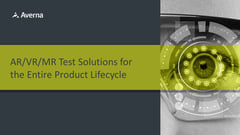
FPGAs are beloved. They have offered astonishingly effective solutions for very complex test scenarios. This is courtesy of their flexibility, their lower cost, and their incredible parallelism. These attributes make them an ideal platform for virtual reality (VR) applications.
Tell Me More about FPGAs!
FPGA stands for Field-Programmable Gate Array. The array in question is a group of integrated circuits on a chip which make up a programmable logic gate. As a result, they exist to execute logic-based tasks. There are several differences between an FPGA and a microprocessor, but one of the greatest advantages that an FPGA offers is a zero-commitment policy. When you buy a central processing unit (CPU), you get the chipset you get and you don’t get upset. With an FPGA the hardware doesn’t change, but the software is designed to be reprogramed as needed to emulate any situation. For example, a Vector Signal Transceiver (VST) is a card that combines a vector signal generator (VSG) with a vector signal analyzer (VSA) and leverages FPGA-based real-time signal processing and control. The world’s first VST from National Instruments featured a user-programmable FPGA, to implement custom algorithms directly into the hardware design of the instrument. This software-designed approach allows a VST to have the flexibility of a software-defined radio (SDR) architecture with RF instrument class performance. This is why the VST was selected to be used with the AST-1000, the all-in-one infotainment signal generator.
The (Virtual) Reality of the Situation
VR has been around for a long time now but has only recently really taken off. The market is estimated to be valued at 20.9 Billion USD by 2025. This is courtesy of a growing variety of VR options out there. This includes high-end total immersion hands-free options like the Oculus Quest 2 and the Cosmos Series from Vive to lower-cost options that use the same elements that can be found in a cellphone. Virtual reality is becoming an actual reality for everybody, but needs to work flawlessly for people to buy in.
The F Should be for Flexible. Or Fast.
As this technology continues to improve, changes and upgrades play a regular role. By designing a platform using an FPGA it becomes possible to completely change image processing specifications depending on the required task or latest upgrade. It is the quality and speed of image processing that makes virtual reality believable. Not only can an FPGA be reprogramed as required, but also processes data in parallel. CPUs may work faster than an FPGA, but not when you consider the relevant data is being managed sequentially. An FPGA can process thousands of items in parallel, speeding up any application significantly.
It cannot be emphasized enough. It is the speed of image and data processing that makes virtual reality, real. Any latency, lag, or pause in what the user is viewing will simply destroy the illusion of being fully immersed. When experiencing VR, the system needs to make you feel like you are IN IT. So virtual reality will factor in the position of your body, location in the room, where your eyes are looking, depth perception and more. Processing all this data simultaneously (as opposed to sequentially) vastly reduces the latency of the application and makes it happen.
Speaking of speed, considering how fast the market is progressing, no one will want to invest in a headset that will be obsolete in a year. By designing a VR platform using an FPGA, updates and upgrades are simple, and can be performed remotely. This is a field where it is a distinct disadvantage to disconnect.
For more information on FPGAs or Virtual/Augmented/Mixed Reality testing, please contact Averna.
You may also be interested in…
Streamline test for VR/AR/MR through the entire product lifecycle. See how Averna’s standardized platform can get your product to market faster!
Get in touch with our experts or navigate through our resource center.
